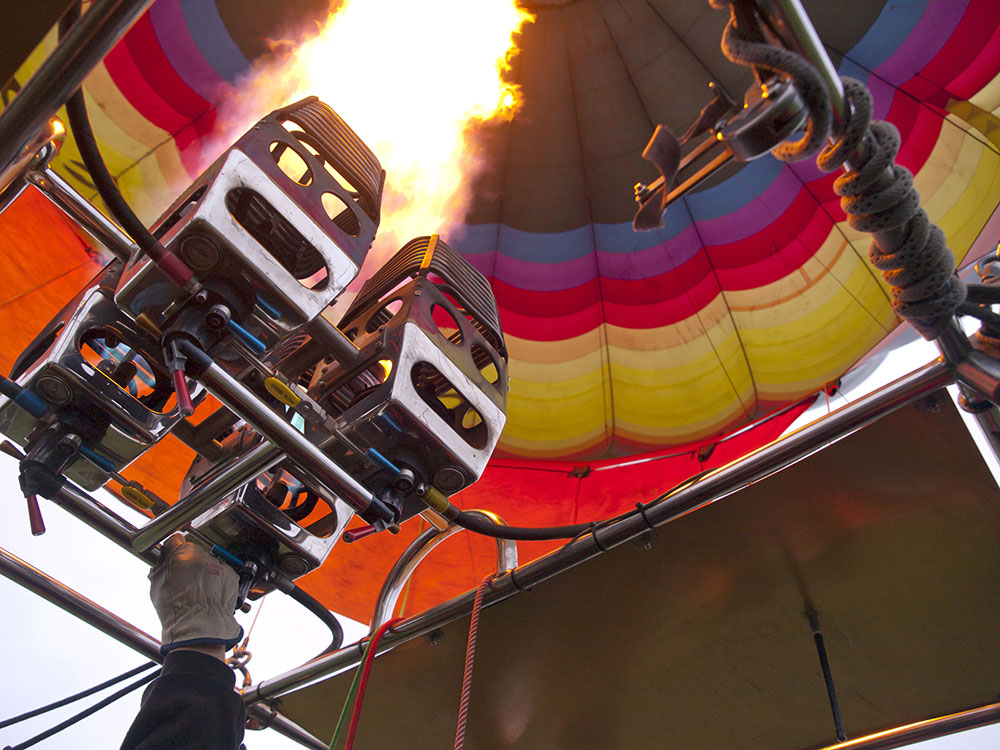Are Hot Air Balloons Safe? What Safety Features Do They Have?

If you’re planning on going on a hot air balloon for the first time, you might be asking how safe they are once you are up in the air and what the chances of an accident are.
Hot air balloons are packed full of safety features such as fire extinguishers, ropes, backup burners and more, the pilots often have safety equipment such as gloves too for handling any gas valves on the balloon.
Down below in our guide, we will discuss how safe hot air balloons are than planes, the main features, what makes a balloon safe and if the weather can affect hot air balloon safety.
Are Hot Air Balloons Safer Than Airplanes?

Before getting into what safety features hot air balloons come with to keep you out of danger, let’s explore one of the most common questions in the relation between safety and hot air balloons, are they safer than a plane?
Well, hot air balloons are regarded as safer than planes, due to the fact they have fewer parts that could go wrong, they also operate at a much lower height and speed than planes, making crashes less fatal.
On average, only one person a year dies from a hot air balloon crash incident in comparison to around 50 deaths a year concerning aviation on planes.
Essential Safety Features On Hot Air Balloons
Hot air balloons are designed and used with safety in mind, they come with numerous features onboard to ensure safety when flying.
We’ve listed the most common ones to find on a balloon below.
- Secondary ignition – No matter what, nearly all hot air balloons will have a secondary ignition source, this comes in a piezo sparker but some pilots might carry a barbecue lighter or welding torch in case the pilot light fizzles out.
- Backup fuel and burner systems – Every hot air balloon will have two fuel tanks that are connected by separate hoses, ensuring a safe lander in case of a fuel leak in one of them.
- Drop a line – A quick-release rope around 30-meters long is included on most hot air balloons, this is designed for use during calmer winds and can be thrown down to ground staff to move the balloons away from obstacles in the ground.
- Fire extinguisher – Most hot air balloons carry a fire extinguisher to get rid of any propane fires.
- Hearing and hand protection – The pilot will likely have gloves that are heat and freeze resistant in case they need to touch the gas valve if it is leaking, they also have hearing protection since they are regularly exposed to burner noise of the balloon which can be loud.
- Clothing – To avoid clothing catching fire, it’s best to wear clothes made out of natural fibres rather than synthetic fibres which can melt and cause burns on people.
Can Weather Affect The Safety Of a Hot Air Balloon?
Now we know the main safety features which come with hot air balloons, there is a main external factor to be aware of which can affect the safety of a balloon, the weather.
Hot air balloons are very weather dependent, the wind direction or risk of rain can all affect whether or not a hot air balloon can take off or if it will be delayed.
- Wind – Wind should only be between 4-6 mph, too strong can change the direction and speed of a balloon, too much wind can impact where you land, too little and the balloon will not move.
- Visibility – The pilot of a hot air balloon needs to be able to see between one and three miles, fog can make navigating a balloon very dangerous.
- Rain and storm – Rain and storms must be avoided for a hot air balloon to be safe, you can’t run away from them like a plane, rain for example can bring the temperature of a balloon down making it much harder to control and potentially come down, all stormy weather is avoided when flying, even if it’s an hour ahead.
How To Take Off & Land On a Hot Air Balloon Safely
As well as safety features onboard a hot air balloon, there are some essential safety precautions for passengers to take to ensure a safe take-off and landing which we will list below.
- Step one – Use the foot holes in the basket of a hot air balloon to board safely then keep your knees bent while holding the handles inside for taking off.
- Step two – Keep your hands and personal items inside of the balloon when moving around after take off.
- Step three – When landing keeps your knees bent again then lean into the back padding of the balloon while holding the handles, never exit until your pilot says it is safe to do so.
Frequently Asked Questions About Safety Features & Hot Air Balloons
How often are their hot air balloon related incidents?
Hot air balloon incidents are rare but often happen due to power line collisions or bad weather, there is only one death per year related to hot air balloons, it is even considered safer than planes.
What are some tips for riding a hot air balloon for the first time?
Riding a hot air balloon for the first time can be nerve-wracking, we’ve listed some tips for beginners here; use the restroom before getting on a hot air balloon, wear warm clothing since it gets colder higher up, take a camera and binoculars.
Does a hot air balloon go down if it gets a hole?
Yes, a hot air balloon will go down if it gets a hole inside since the hot air will escape and allow cool air inside, ruining the convection process through buoyancy.
Final Words
To conclude, hot air balloons come with many different safety features to keep you safe such as a backup ignition, fire extinguisher and drop line to guide the balloon away from any obstacles. Hot air balloons are one of the safest ways to fly out there and are a great experience, the biggest threats to hot air balloon safety are strong winds and power lines.
I’m Annie, a twenty-something year old girl who loves hot air balloons. So much so, that I have a full time job as a Flight Instructor and it is all I love talking about. Something about being up there in the elevated altitudes helps all my stresses float away!

Can you ware a safety harness please?